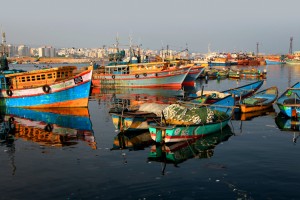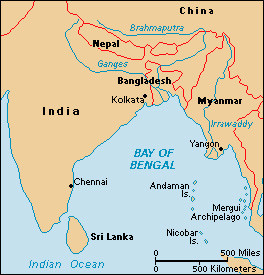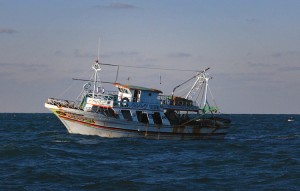Breaking Point in the Bay of Bengal
June 29, 2017
The Bay of Bengal forms the northernmost part of the Indian Ocean. Bordered in an arc by the populous nations of Sri Lanka, India, Bangladesh, and Myanmar (also called Burma), the bay plays an important role in the lives of hundreds of millions of people. For thousands of years, people have subsisted on the bay’s rich marine life. With its waters dirtied and its sea populations dwindling, however, the bay’s fruitful abundance is lessening and may soon come to an end.

Traditional fishing boats crowd the harbor at Visakhapatnam, India, on the Bay of Bengal. Larger trawling vessels can be seen in the background. Credit: © Shutterstock
Covering an area of some 840,000 square miles (2.2 million square kilometers), the Bay of Bengal is one of the world’s largest marine ecosystems. The bay’s deep waters, coral reefs, estuaries, and mangroves provide a remarkable diversity of life. The rare Irrawaddy dolphin, which lives in fresh and brackish (slightly salty) waters, lurks in the muddy river mouths along the coasts. The bay’s salty and swampy mangrove forests provide a key habitat for Bengal tigers in India and Bangladesh, and for saltwater crocodiles, river terrapins, and other endangered species throughout the region. The dynamic mix of salt and freshwater habitats makes the coasts hotspots of fish biodiversity as well. At least 24 species of shrimp, 50 species of crab, and hundreds of different types of mollusks live in the bay’s shallower waters. These waters also host an abundance of squid and octopus species.

Click to view larger image
The Bay of Bengal is the northern part of the Indian Ocean. The bay borders on India, Bangladesh, Myanmar, and Sri Lanka. Credit: WORLD BOOK map
The Bay of Bengal is best known, however, for its rich fishing. Seemingly endless populations of tuna, mackerel, sharks, reef fish, prawns, oysters, and other marine animals have long provided people with food and a steady income. For centuries, people fished the bay with pole and line, they trolled from light boats, or they practiced beach seining (hauling in nets anchored to the beach). These methods—which are still common today—produced ample results for both home and market, yet they did little harm to the bay’s overall fish stocks. Over the past 50 years or so, however, industrial fishing—which leans heavily on the use of trawlers—has largely supplanted the traditional sustainable fishing techniques, and the results have been disastrous.

Even such small stern trawlers as the one above catch large amounts of fish, including non-commercial marine species known as bycatch. Credit: © Colin Munro, Alamy Images
Trawlers use funnel-shaped nets called trawls to trap sea life. Trawls are very effective at corralling huge quantities of sea life, particularly valuable shrimp and prawns (often referred to as “pink gold” in the Bay of Bengal). A single trawler can catch many more fish in a day than a dozen or more traditional fishing craft. But trawling is a destructive fishing practice that can devastate marine ecosystems. The heavy trawls, usually weighed down and dragged along the sea floor, do not discriminate. They catch everything too big to slip through the net, including dolphins, rays, sea turtles, and many types of other non-commercial fish. These accidental catches are swept up in the nets, hauled on board the ship, and dismissed as bycatch. Some animals caught as bycatch are returned to the sea alive, but most die and are either discarded or sold to produce farm animal feed. Bycatch can constitute as much as 90 percent of a trawler’s haul—a devastatingly inefficient and wasteful percentage. Trawlers can leave a swath of lifeless sea in their wake, and they also hurt the sea floor itself. The heavy nets mow down sensitive corals and plant life.
In the Bay of Bengal, the switch from local to corporate and industrial fishing—to unsustainable and destructive trawling—has largely depleted the waters’ once-rich fish stocks. As fish hauls have decreased over the years, many traditional fishing families have had to find other ways of life. At the same time, trawling fleets—pushing ever further to find their elusive catch—have caused international disputes as they encroach upon foreign nations’ territorial waters.
Overfishing has done great harm to the Bay of Bengal, but ocean pollution may be the bay’s greatest enemy. Pollution has killed large amounts of marine life, poisoned or otherwise contaminated the bay’s waters, and even drained the life-giving abilities of the water itself. In some areas—including a massive “dead zone” in the middle of the bay—the once organically rich marine environment has become a tangled web of plastic garbage floating on oxygen-poor waters nearly incapable of supporting life.
Water pollution in the Bay of Bengal comes from many sources. Deep-water gas and oil drilling can cause great harm, as can ever-running boat engines and acid rain falling from the polluted air of the “brown cloud” drifting from the Asian mainland. The largest amounts of pollutants, however, come from the bay’s feeding rivers. Many major rivers empty into the Bay of Bengal, including the Meghna, the Ganges, and the Mahanadi. These mighty rivers carry fresh water into the salty bay, but they also bring pesticides and fertilizers from farming lands as well as massive amounts of trash and untreated sewage from urban areas.
Aside from the obvious harm from toxins, fertilizer runoff provides the bay’s plankton with an excess of nutrients. This causes the plankton population to rise sharply. The plankton then use up much of the water’s oxygen supply, leading to areas of hypoxic (low oxygen) waters. Few marine species can exist in hypoxic waters, so most animals either die or go elsewhere. In the center of the bay, a 37,000-square mile (60,000-square kilometer) area devoid of fish has appeared—a massive hypoxic zone often referred to as “dead.” Without action to reverse the bay’s decline, this dead zone may grow until, one day, it takes over the entire bay.
Anthropogenic (human caused) climate change, too, is threatening the Bay of Bengal. Climate change affects southern Asia’s seasonal monsoons, causing erratic, stronger, and unpredictable storms and flooding, increasing freshwater runoff and pollution and further deoxygenating the bay’s waters. Global warming leads to warmer ocean water temperatures and encourages the expansion of low-oxygen or even anaerobic (oxygen free) dead zones. Warmer ocean waters also melt polar ice at an increased rate, which causes sea levels to rise. As water inches up the Bay of Bengal’s coastline, it will displace millions of people. It will also take away land badly needed for agriculture, forcing humans to rely still further on fish from the bay—fish that soon may be nearly impossible to find.
As food security in Bay of Bengal countries becomes increasingly threatened and marine species become harder to find, slowing—or, if possible, reversing—the demise of the Bay of Bengal will become increasingly urgent. Bay communities and governments must choose more sustainable methods of fishing as well as more responsible methods of agriculture and commerce. At the same time, they must do their best to reduce pollution and waste. Many scientists see the plight of the Bay of Bengal as a warning signal to the rest of Earth. The bay is an example of a global trend in which unsustainable fishing methods, pollution, and climate change are slowly killing the world’s oceans. The Bay of Bengal is at a breaking point, but it is not too late to save it. Swift immediate and long-term action is needed, and the area’s people must make a genuine commitment to environmental responsibility.


